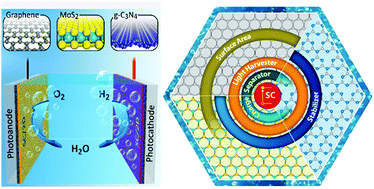当前位置:
X-MOL 学术
›
Energy Environ. Sci.
›
论文详情
Our official English website, www.x-mol.net, welcomes your feedback! (Note: you will need to create a separate account there.)
Two-dimensional materials in semiconductor photoelectrocatalytic systems for water splitting†
Energy & Environmental Science ( IF 32.5 ) Pub Date : 2018-10-10 00:00:00 , DOI: 10.1039/c8ee00886h Monireh Faraji 1, 2, 3, 4, 5 , Mahdieh Yousefi 2, 4, 6, 7 , Samira Yousefzadeh 1, 4, 8, 9, 10 , Mohammad Zirak 1, 4, 11, 12 , Naimeh Naseri 1, 2, 3, 4 , Tae Hwa Jeon 13, 14, 15, 16 , Wonyong Choi 13, 14, 15, 16 , Alireza Z. Moshfegh 1, 2, 3, 4, 6
Energy & Environmental Science ( IF 32.5 ) Pub Date : 2018-10-10 00:00:00 , DOI: 10.1039/c8ee00886h Monireh Faraji 1, 2, 3, 4, 5 , Mahdieh Yousefi 2, 4, 6, 7 , Samira Yousefzadeh 1, 4, 8, 9, 10 , Mohammad Zirak 1, 4, 11, 12 , Naimeh Naseri 1, 2, 3, 4 , Tae Hwa Jeon 13, 14, 15, 16 , Wonyong Choi 13, 14, 15, 16 , Alireza Z. Moshfegh 1, 2, 3, 4, 6
Affiliation

|
Hydrogen (H2) production via solar water splitting is one of the most ideal strategies for providing sustainable fuel because this requires only water and sunlight. In achieving high-yield production of hydrogen as a recyclable energy carrier, the nanoscale design of semiconductor (SC) materials plays a pivotal role in both photoelectrochemical (PEC) and photocatalytic (PC) water splitting reactions. In this context, the advent of two-dimensional (2D) materials with remarkable electronic and optical characteristics has attracted great attention for their application to PEC/PC systems. The elaborate design of combined 2D layered materials interfaced with other SCs can markedly enhance the PEC/PC efficiencies via bandgap alteration and heterojunction formation. Three classes of 2D materials including graphene, transition metal dichalcogenides (TMDs), and graphitic carbon nitride (g-C3N4), and their main roles in the photoelectrocatalytic production of H2, are discussed in detail herein. We highlight the various roles of these 2D materials, such as enhanced light harvesting, suitable band edge alignment, facilitated charge separation, and stability during the water splitting reaction, in various SC/2D photoelectrode and photocatalytic systems. The roles of emerging 2D nanomaterials, such as 2D metal oxyhalides, 2D metal oxides, and layered double hydroxides, in PEC H2 production are also discussed.
中文翻译:

半导体光电催化系统中用于水分解的二维材料†
通过太阳能水分解生产氢(H 2)是提供可持续燃料的最理想策略之一,因为这仅需要水和阳光。在实现高产氢作为可循环能源载体的过程中,半导体(SC)材料的纳米级设计在光电化学(PEC)和光催化(PC)的水分解反应中都起着举足轻重的作用。在这种情况下,具有卓越的电子和光学特性的二维(2D)材料的出现已将其应用于PEC / PC系统引起了极大的关注。合并的二维层状材料与其它的SC接口的精心设计可以显着地提高PEC / PC效率经由带隙改变和异质结形成。本文详细讨论了三类2D材料,包括石墨烯,过渡金属二卤化物(TMDs)和石墨氮化碳(gC 3 N 4),以及它们在H 2的光电催化生产中的主要作用。我们重点介绍了这些2D材料在各种SC / 2D光电极和光催化系统中的各种作用,例如增强的光收集,合适的能带边缘对准,促进的电荷分离以及在水分解反应过程中的稳定性。还讨论了新兴的2D纳米材料(例如2D金属卤氧化物,2D金属氧化物和层状双氢氧化物)在PEC H 2生产中的作用。
更新日期:2018-10-10
中文翻译:

半导体光电催化系统中用于水分解的二维材料†
通过太阳能水分解生产氢(H 2)是提供可持续燃料的最理想策略之一,因为这仅需要水和阳光。在实现高产氢作为可循环能源载体的过程中,半导体(SC)材料的纳米级设计在光电化学(PEC)和光催化(PC)的水分解反应中都起着举足轻重的作用。在这种情况下,具有卓越的电子和光学特性的二维(2D)材料的出现已将其应用于PEC / PC系统引起了极大的关注。合并的二维层状材料与其它的SC接口的精心设计可以显着地提高PEC / PC效率经由带隙改变和异质结形成。本文详细讨论了三类2D材料,包括石墨烯,过渡金属二卤化物(TMDs)和石墨氮化碳(gC 3 N 4),以及它们在H 2的光电催化生产中的主要作用。我们重点介绍了这些2D材料在各种SC / 2D光电极和光催化系统中的各种作用,例如增强的光收集,合适的能带边缘对准,促进的电荷分离以及在水分解反应过程中的稳定性。还讨论了新兴的2D纳米材料(例如2D金属卤氧化物,2D金属氧化物和层状双氢氧化物)在PEC H 2生产中的作用。


























 京公网安备 11010802027423号
京公网安备 11010802027423号